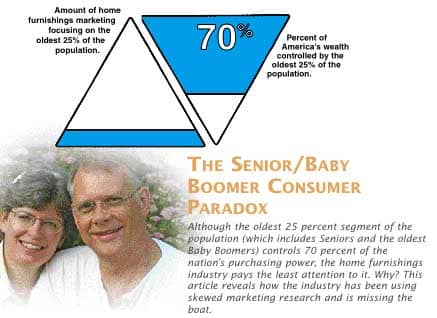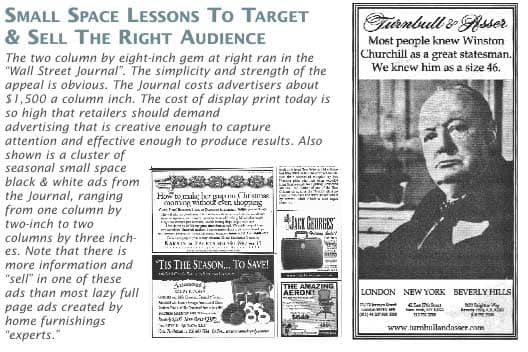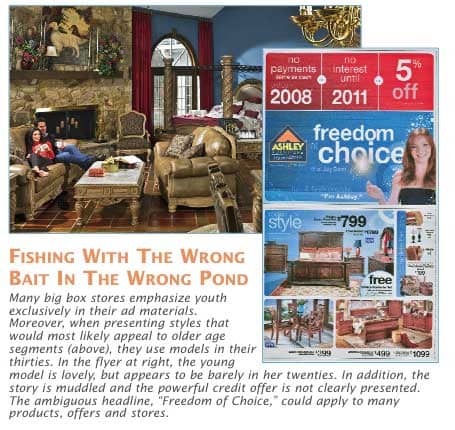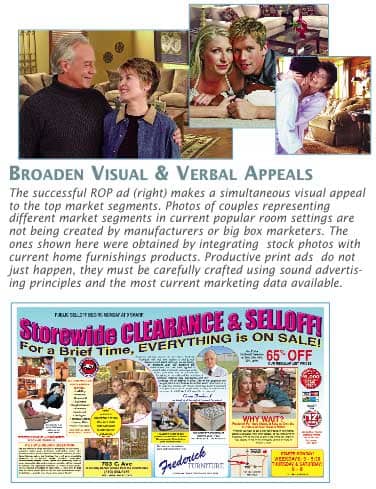The best-kept secret in marketing furniture is that the vast majority of furniture stores are targeting the wrong customers. Why? Because the conventional approach in the home furnishings industry is to count the number of households in a market area and target “the woman of the house”.
An extensive new report from TRENDS1 reveals that this idea is out-moded and is costing furniture retailers a great deal of business. If we target per capita buying power, instead of the average household in our market area, a remarkable new picture emerges.
The truth is that the oldest 25 percent of the population (which includes Seniors and the oldest Baby Boomers) controls 70 percent of the nation’s purchasing power. It is clear from voluminous reports that Seniors and Baby Boomers are going to dominate the first half of the 21st century. Not only do they control most of the wealth of the country, they are big spenders.

Because this new breed of Seniors is largely ignored by furniture stores, the door is wide open for smart furniture entrepreneurs in certain markets to start mining for the gold that is waiting out there. Some techniques will be presented later in this article, but first, let’s see how the home furnishings industry (and marketing in general) got off target.
Most business and media executives have an ingrained prejudice against Seniors. They have a durable belief that Seniors are set in their ways, frugal and uncool. Why? TRENDS says that the CEO of WPR Group USA (which owns the huge agencies of J. Walter Thomson, Ogilvy & Mather, and Young and Rubican) points out that creative staff members in ad agencies tend to be between 25 and 35 years old. This seems to be true of most of the ad “experts” in the big box furniture chains as well. Reaching the massive Senior and Baby Boomer home furnishings markets may require insights that are not on the radar screen of a 30-year-old advertising expert. This prejudice also affects sales consultants. Psychologists tell us that we immediately pre-evaluate a prospective customer according to certain visual clues, and a customer’s age is high on the list. Young sales consultants are too often unaware that when an older couple walks through the door it is not a lost up, but may be a great sales opportunity.
But how did we get caught up in worshiping the youth culture? It began back in the sixties, when advertisers and the youth culture merged. Today, aging Baby Boomer executives still think of themselves as young and continue to have a prejudice against the Senior market defined as anyone born before 1946 (there are 55 million of them). But the Senior of today is very different than the stereotype of old. They are part of the so-called “Greatest Generation” who grew up in the Depression and fought in World War II?but also the “Quiet Generation” born between 1927 and 1945. Collectively, they are a formidable market force that is generally ignored by furniture marketers. Seniors grew up in the Depression and then created today’s booming economy. They worked hard and sacrificed, built the suburbs, the auto industry, and the interstate highway system. They were brought up on radio, movies, and newspapers as media, and were the very first television audience. Although they crafted a conformist society and maintained respect for authority, Seniors are progressive. Today they are spending three times more than the average consumer on the internet.2 And they like advertising that recognizes them for who they are and what they have achieved. Seniors comprise a rich, untapped market for the smart furniture store that goes after it.

DON’T NEGLECT THE BABY BOOMERS
78 million Baby Boomers were born between 1946 and 1964. They are just turning gray and are setting America’s economic pace. The TRENDS report pointed out that this group will always think of themselves as “young,” and that is why they confound the marketing gurus. Furniture stores are reaching out to an imaginary customer, and they have it wrong. Today’s youth have a different mind-set, different values, and a different point of view. Boomers are said to have “old values” but “new needs.” Furniture stores are seeing their sales decline largely because they are focusing on an illusion and missing out on the huge amounts of cash that people (often their own age) are spending.
Boomers are demanding, because at every stage of their lives society has made changes to conform to their expectations. Having weathered the tumultuous period of Vietnam and the Cold War, Boomers now may become the first generation in history to make growing older a “cool thing.” They were brought up on TV advertising, and invented the computer. While only 37 percent of households have a Baby Boomer at the helm, more than half of those households have annual incomes in excess of $100,000.

Boomers spend more money than any other age group, and the gap is widening. It is estimated that by 2010 Boomers will be spending a trillion dollars more annually than all the people under the age of 45.
Even so, most marketing gurus recommend that furniture stores continue to put considerable focus on the under 35 age group, whose incomes shrank between 2001 and 2004, while Boomer incomes were rising. Research indicates that furniture marketers have not formulated effective appeals for Boomers, even though most of the power players in the home furnishings industry are Boomers themselves. Boomer-Consumers over fifty aren’t looking for “young” messages. They want shopping experiences like the ones they enjoyed earlier in their lives… back when a sales consultant recalled their names and favorite brands, and remembered the last time they were in the store. Computer software that can personalize this information and serve it up instantly to salespeople will help turn the economic tide for those who adopt it. Furniture stores that strive to understand and focus on what Boomers really want will thrive in the years ahead. Before we explore ways to do this, let’s take a quick look at Generations X and Y.
WORKS IN PROGRESS: X AND Y
Both Generations X and Y need to be understood as groups that are in the process of building wealth and influence. Xers were born from 1965 to 1983 and consist of about 60 million persons. They have an entirely different mindset than Seniors and Boomers. Many of them have suffered through divorce and family disintegration. They grew up with cable TV, CDs and VCRs. They distrust institutions and big business. Many are concerned with the environment and social justice. They want advertisers to tell them an honest story, and furniture stores to provide good service and excellent products. Even though they are tough to convince, they are in the process of becoming aggressive spenders. They will pay more for quality and luxury, but they also want the ability to customize their selections. Advertisers struggle to appeal to this tough customer, and permission marketing strategies are key. Xers are self-confident, not afraid to question authority, and they prize their own individuality. Most experts agree that they will remain the most difficult market segment to crack, and the most problematic employees to understand and motivate.
Generation Y, or the Millennials, are an emerging market force. They were born approximately between 1980 to 2004, and comprise a huge market segment of 76 million. Cell phones, iPods, and electronic games are essentials to them; and they grew up in a world of PCs, DVDs, and VCRs. Millennials are idealistic, socially active and involved ? and indulged. They move easily through a hyperspace world of blogs, text messages, and downloads from MySpace and other networking sites. They are impatient, and used to getting what they want when they want it. Even so, Millennials are good team players and like working with groups. Eventually, they will dominate and configure the markets that serve them and revolutionize marketing. But not in the immediate future.
A STRATEGY FOR TODAY’S FURNITURE DEALER
All of the above material has been carefully researched and is based upon solid, verifiable facts. And the facts lead us to one inescapable conclusion: We need a new marketing strategy that targets an ignored opportunity to sell more home furnishings. This opportunity is based upon a graying workforce with enormous buying potential and in no hurry to retire. They do not consider themselves old, they are more physically fit and mentally alert than the previous generation of workers who routinely retired at 65.
They are also largely neglected by big-ticket retailers. So forget appeals to Generation X and Y because they aren’t listening. Keep in mind this riveting fact: The oldest 25 percent of the population (which includes Seniors and the oldest Baby Boomers) controls 70 percent of the nation’s purchasing power. They are internet savvy, yet they also read newspapers, direct mail offers, listen to radio and watch TV. If you can tell your story effectively, they will listen and respond.
In previous articles the need to have a story and tell it has been discussed. Check out the “Seven Keys To Advertising Success” from the February 2000 issue of FURNITURE WORLD Magazine (posted to the article archives on www.furninfo.com, noting especially the on line review and summary. Also important for marketing to the Senior and Boomer group is the series on “The Culture Code, The Code That Unlocks Customers’ Hearts & Wallets”. For the balance of this article I will assume you buy into the idea that you have a great story to tell and you understand the need to tell it. The principles of persuasion remain the same. However, we are going to fine tune and adjust our strategies somewhat to more effectively capture the interest of the Senior and Boomer consumer.
Present this article to your key staff members and encourage them to brainstorm. This is more than an exercise, it will bring your staff to another level of awareness and allow them some ownership of a whole new tool kit of marketing ideas. Please send any insights or suggestions regarding the Senior and Boomer consumer you want to share to Furniture World Magazine at lmullins@furninfo.com.
1. PRINT MEDIA GRAPHICS: take a look at any recent flyer from a big box furniture advertiser. It is a rule of thumb in furniture advertising to show a beautiful young model or a young couple in a home furnishings setting. Very rarely, if ever, is a mature couple shown. Begin to introduce illustrations of Boomers and Seniors into your direct mail, flyers and ROP newspaper illustrations.
2. PRINT MEDIA ADVERTISING APPEALS: begin to offer special discounts and add drop-in messages to Seniors and Boomers. Create a drop-in with a message along these lines: “50 YEARS YOUNG … or Older? Give us a call, drop by, or email us at furniture@XYZstore.com and get your special discount card, applicable to any price, sale or otherwise, in our store. It’s free and there is no obligation.”
In this way you can begin capturing names and create a direct mail and email exclusive permission marketing list of Seniors and Boomers. Be the first home furnishings store in your area to do this and you will reap big dividends.
3. “SILENT SALES PERSON” FOLLOW-UP. Follow up with a few “silent salespersons” (signs) in your store that relay and enforce the same message. Create a simple form to capture the information, and possibly a flyer of some kind. Possibly build the story and message around the theme of a salute to the great generations that sacrificed and built the prosperity we now enjoy.
4. PEOPLE MEDIA. People Media are the most powerful media you can use and they are free. People media consist of what you tell your managers and your staff. And also: what they tell each other, your customers, your vendors, their friends and the community at large. Make sure you carefully craft and communicate the message of this article to your managers and staff. Although this is not rocket-science, keep in mind that most of the members of your staff are not Seniors or Boomers. The message of this article may be a complete reversal of their mind-set against the graying population. But, as professionals who want to make more money, you will be giving them a whole new set of tools they can use to unlock an immense “Blue Ocean” of selling opportunities.
5. INTERNET GRAY POWER. Keep in mind the surprising fact that Seniors and Boomers are progressive; today Seniors are spending three times more than the average consumer on the internet. They are not likely to buy furniture there, but they are very likely going to surf your website. Make sure your messages and graphics reflect an enlightened, Senior-savvy attitude.

6. SENIOR and BOOMER CONSUMER SEMINARS. Check out the recent series of articles in Furniture World by Margarett DeGange, M.Ed. Margarett that reveals a great deal of valuable information about staging a decorating seminar. Put on your thinking cap, brainstorm with your staff, and tailor a special series of decorating seminars targeted to the Seniors and Boomers in your area.
7. SHOP AT HOME. Review the article in Furniture World from the October/November 2006 issue (posted to the article archives on www.furninfo.com) titled “Blue Ocean Marketing, Part 2”. This article provides the bones for creating a shop-at-home program. It should be obvious that this shop-at-home concept will beautifully lend itself to a program of marketing to Seniors and Boomer consumers.
This new marketing paradigm cannot be fully explored in a single article, but these starter ideas will get you on track to discover a whole new universe of opportunity. Be first, and be outrageously better than your competitors. Keep in mind that this is a rare chance to out-market the big-box strategists.
In the next article in this series we will explore yet another new avenue of Blue Ocean possibilities. New concepts in Word of Mouth Marketing, or PEOPLE MEDIA, can open fresh new doors of marketing effectiveness undreamed of by most of the marketing gurus.
1 TRENDS: Volume 5, Number 9, www.crucialtrends.com
2 Zona Research study.
Contributing Editor Larry Mullins has 30+ years experience in the front lines of furniture marketing. Over the past ten years he has developed a Visionary Management program that can impact the culture of an entire organization and bring it to life. He also produces state-of- the-art promotional advertising packages for everything from quick cash flow to complete exit strategies and store closings. Larry is the President of UltraSales, Inc.. Questions on any aspect of this article can be sent to Larry care of FURNITURE WORLD at mullins@furninfo.com.
See more articles by Larry in the marketing management archives on furninfo.com.